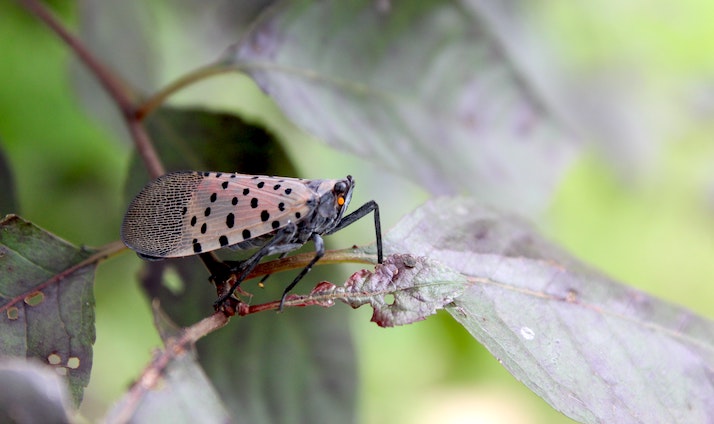Urban Agriculture | January 25, 2023
How to Treat a Spotted Lanternfly Infestation
 An adult Spotted Lanternfly with closed wings. Photo credit: Unsplash/Magi Kern
An adult Spotted Lanternfly with closed wings. Photo credit: Unsplash/Magi Kern NYRP Deputy Director of Urban Agriculture Corey Blant compiled this guidance based on his experience in local parks and gardens. Learn more about our Urban Agriculture program and resources here.
Download and print NYRP’s Spotted Lanternfly Pest Alert poster here.
If you were in the New York City area this past August, it would have been hard to miss the onslaught of the Spotted Lanternfly (SLF). The clumsy insects were suddenly everywhere: sidewalks, subway platforms, the sides of Midtown office buildings. I even had an encounter on the roof of my six-story apartment building!
As you might have seen in a slew of news outlets, a variety of environmental agencies across the East Coast officially put out an order to kill and report any SLF on-site (squishing or stomping are the more popular recommendations although freezing works, too). Public agencies also tried to educate about the importance of destroying egg masses, but those can be harder to find and identify.
Though there are plenty of creatures we love to hate, this sort of highly public campaign against a single agricultural pest is atypical. Why all the hype, and is squishing one-off bugs really a useful strategy to control an infestation?
View this post on Instagram
What’s a Spotted Lanternfly and Why Are They a Problem?
SLF is an invasive species in our area. That means that they are not native to this region, don’t have any natural predators here, and as a result, can undermine the health of our local ecosystems and farms. Scientists think they traveled to the northeastern United States from their native Asia on a shipment of stone around 2012, and they’ve rapidly spread throughout the region over the past decade.
The lanternfly is technically a leafhopper—not a fly—with piercing-sucking mouthparts called beaks. Think of them as vampire bugs who prey on plants, except that they can’t pierce human skin, nor can they even break the protective skin of most fruits. In fact, it isn’t until they reach adulthood that their beaks are strong enough to serve their intended purpose of drilling into tree trunks and plant stems and feed on the sap. That’s when they can wreak havoc.
When a SLF feeds, it robs the host plant of hard-earned nutrients and produces a substance called “honeydew,” or a sort of bug poop, in the process. In some cases, this parasitism will lead to a substantial and rapid decline. This is especially true for grapes and has led many experts to worry about the economic impact the Spotted Lanternfly could have on New York’s vineyards and wine industry. In other plants, the honeydew and black sooty mold, a fungus that can grow along with it, are mostly considered annoyances.
Adult Spotted Lanternflies will bore into a wide range of fruit trees, ornamental perennials, and woody plants. The list of known hosts in the northeast is more than 50 species long. The Tree of Heaven (Ailanthus altissima), an invasive tree that also hails from Asia and has been a ubiquitous presence in New York City for decades (it’s the A Tree Grows in Brooklyn tree), is believed to be the SLF’s preferred host. In urban agriculture spaces like community gardens and urban farms, we often see them on grape vines. Fortunately, SLF has mostly left annual vegetable crops alone thus far, although there have been reports from Staten Island of young lanternflies taking a liking to okra and cucumber plantings.
How to Manage a Spotted Lanternfly Infestation
The best practice right now for dealing with a Spotted Lanternfly infestation is to vacuum them up. Unfortunately, there’s no tried-and-true practice to entirely eliminate SLF in a particular area. However, we tried this method in our New York Restoration Project gardens this season and found it minimized the intensity of infestation.
View this post on Instagram
Even a moderately powerful shop vacuum can be an effective tool. Suck up any lanternflies you find at least once per week or more if you’re able. The SLF usually won’t survive the vacuuming process, but if you want to be safe, you can set it aside for a day or two before emptying it in the trash (SLF can’t survive more than two days without feeding). It can be a lot of work, sure, but it does really help to lessen the impact of Spotted Lanterflies on your grape vines or any other plant they might have targeted.
Our Spotted Lanternfly Future
Scientists are also actively testing other solutions to address agricultural infestation, including a couple of organic sprays that show some promise. For now though, the best options for dealing with an SLF outbreak in your backyard or garden involve removing them manually. Seeing their rapidly spreading infestations might make controlling them seem like an impossible task, but experts are finding reasons to be cautiously optimistic.
When asked about the Spotted Lanternfly future in our area, Cornell Cooperative Urban Agriculture Specialist Sam Anderson says “Clearly, it’s not going to kill everything. We’ve seen in places like Pennsylvania, that have been dealing with them for a decade now, that SLF doesn’t leave a wasteland in its wake.” And, looking forward, he reminds us that with this sort of invasive pest, “eventually something shows up or is introduced that brings it into a sort of equilibrium.”
The question for us in the New York area is when that’s going to happen, and how much of a pain the Spotted Lanternfly will be in the meantime.
Download and print NYRP’s Spotted Lanternfly Pest Alert poster here.